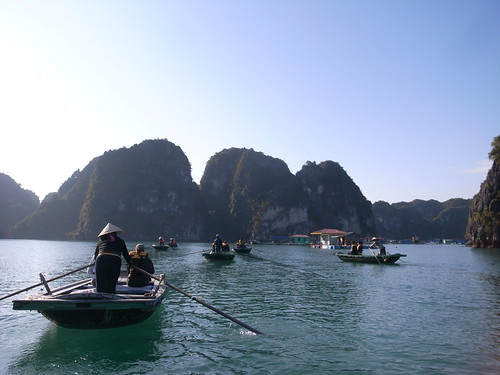 PREFACE
Lost in Luang Prabang
PREFACE
Lost in Luang Prabang
Our honeymoon was broken up into three different parts split between three countries, and two climates. Northern Vietnam was meant to be the adventurous leg of it.
Hanoi is loud. Damn loud. Instead of using turn signals, cars honk to indicate their next move. Not many traffic lights, only massive roundabouts and five-way intersections. One surprised taxi driver honked his way through chaos, then suddenly, his horn broke. Freaked out, the taxi driver slowed down and proceeded as though he were getting his learners permit. Hilarious: an unarmed taxi driver in the middle of a horn war.
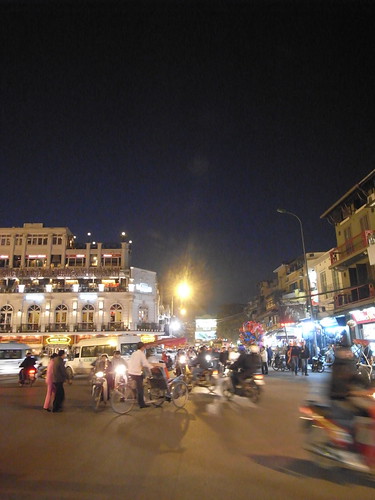
Hanoisy.
It's my vote for the noisiest place on the planet. To survive crossing roads as a pedestrian, move slowly and directly to where you need to go. No running (your first instinct), take a deep breath and cautiously float through. This is the only way to get to your next pho.
Aside from the noise, it is great. The architecture, drinks, and food is all good. I was in search of northern-style pho--I heard about these thicker fatty noodles and wanted to get the real deal. We were lead astray at first by our guide who ditched us at the place with the best view and worst food in the old quarter.
Street meat: chicken parts.
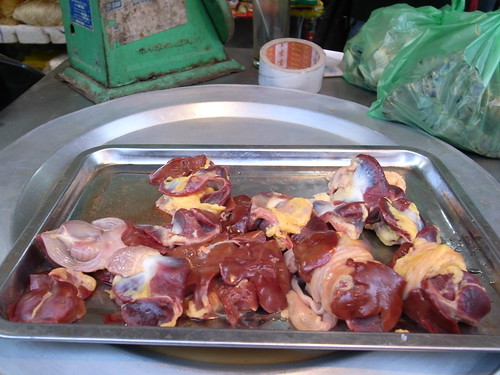
Mobile baguette vendors--a reminder of the former French empire.
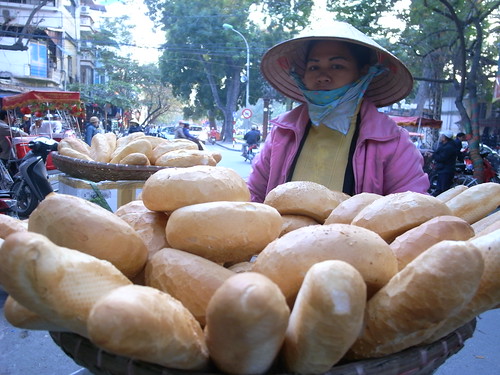
Meat vendors.
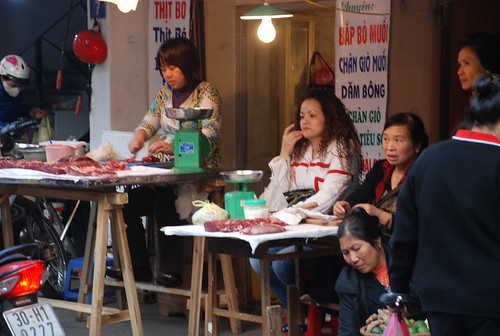
Vegetable vendors.

Pho destination.
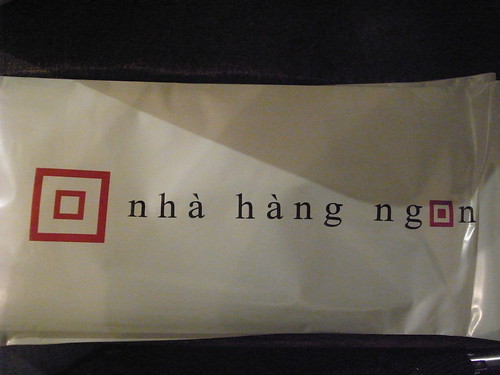
A little help with the menu got us our first
nem (the sexier word for "spring roll from god"):
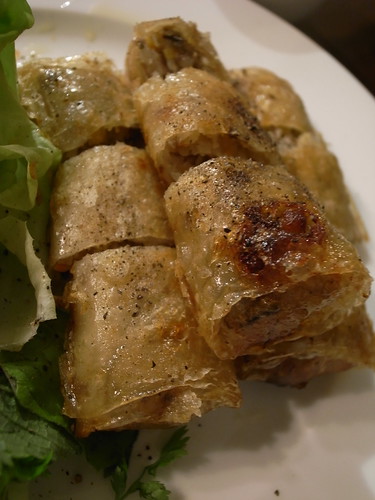
The pho ruled--not because it was particularly memorable, but because this is what everyone else ate. It was hot and welcoming.

The pho wasn’t spiced up to please the massive flow of foreign travelers, cause there weren’t any. We ate, slept and headed out to Halong Bay with bellies full of thick fatty noodle pho-ness.
Halong Bay is a massive archipelago in the Gulf of Tonkin. The many islands spring out of the water like giant dragon teeth here and there and everywhere. This little cove is a World Heritage Site.
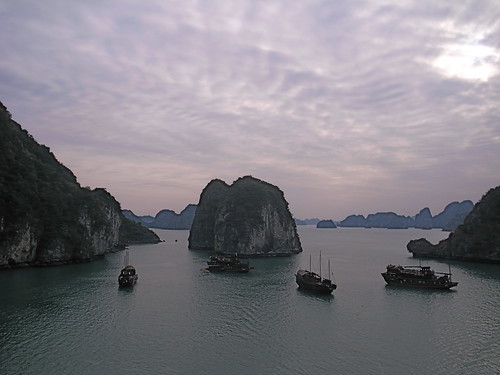
Arriving at Halong Bay was a little bit like arriving at a cattle ranch: pushed out of our van and huddled into a banquet room awaiting what’s next. Here we were assigned “Bobby” the kind, yet dead pan, robotic-voiced guide. Bobby sharply and efficiently shouted out our names, then moved onto the next “RO-BOT!” or as the others knew him, Robert from Long Beach.
We got on our Junk, which is not the lovely between the leg region, but a large wooden pirate-esque ship with giant fan sails. The fleet of Junks quickly swallowed up their tourists and took them away.

The above photo is of a woman paddling some tourists from our trip to a little water village. All the paddlers were women. Tough as nails.
First Junk meal was (surprise!) pho of the more flavorful variety,
pho ga, with shredded chicken.
For dinner entertainment: a massive display of pumpkin art, which we were heavily encouraged to clap for as Bobby proudly displayed the next. These displays put North American Halloween pumpkin-carving to shame.
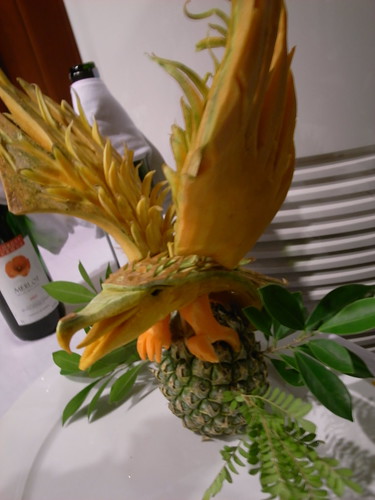
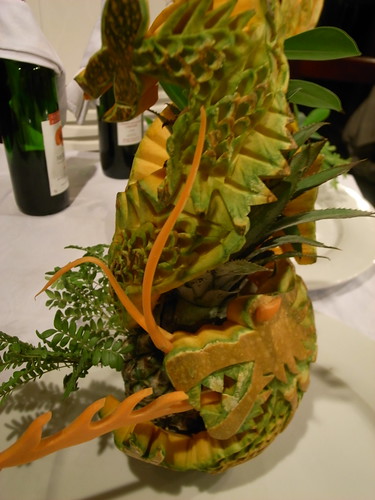

On our first night on the Junk we were given a happy honeymoon cake, hand-delivered by Bobby and the Captain personally.
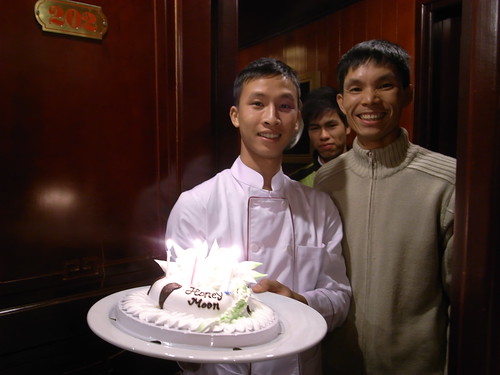
The next night we ate a plateful of crab. Vietnam doesn’t joke about their seafood.
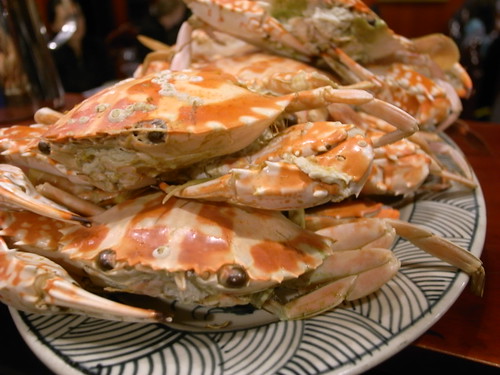
An overnight train landed us in Sapa the old mountain town overlooking the border with China.
Sapa is home to at least ten ethnic minorities. We encountered mostly Flower H’mong, Black H’mong, and Red Zhao.
Flower H'mong:

Black H'mong.
phot0 courtesy of CH
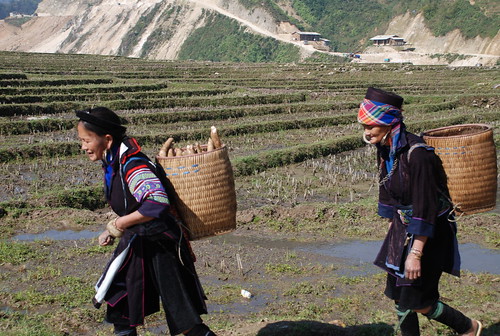
Red Zhao:
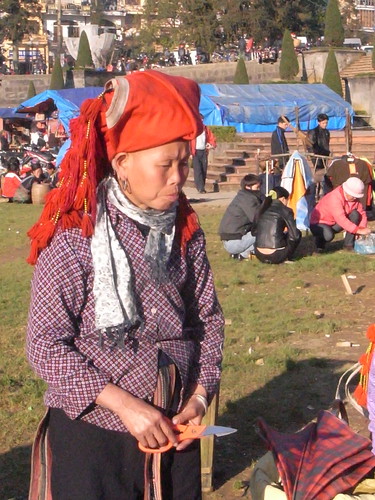
All the
H'mongs were very friendly, intricately dressed, and pushing their handicrafts. And talking on the phone.

At the Can Cao market in the high-rice terraced mountains we found thousands of colorfully clad Flower H’mong women buying up their new garments. From a distance, all the garments look the same, reminding me of the four pairs of blue jeans I had at home--and how that must look to outsider eyes.
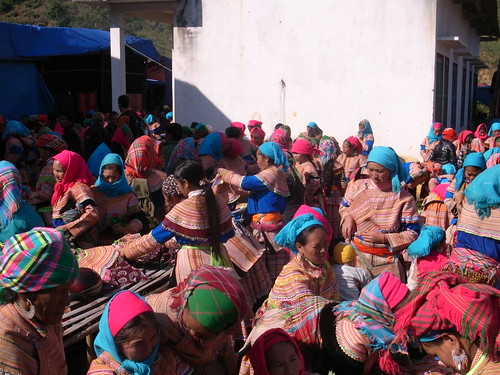
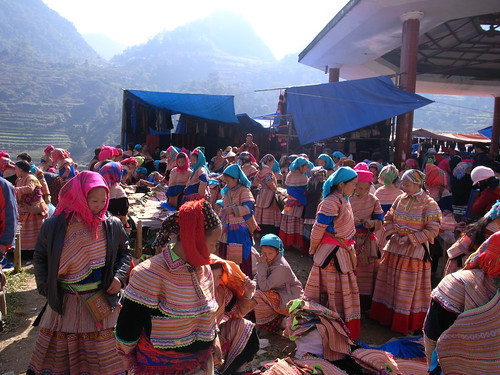
Check the detail.
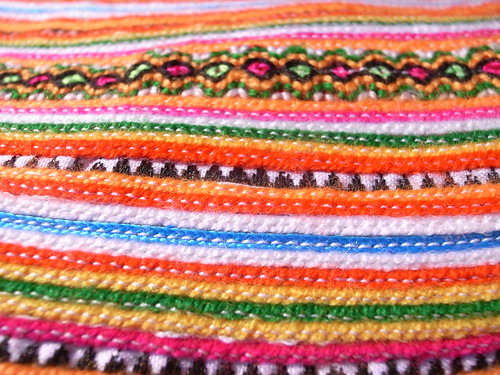
The Can Cao market is the most important day of the week for this community. They don their best gear and walk up to 30 kilometers to buy and sell their garments, peanuts, dried peppers, rice, cane, and handicrafts.
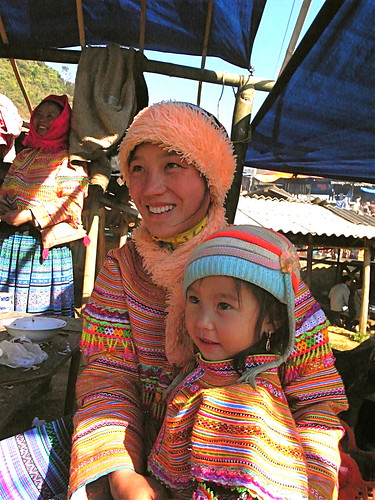
Their husbands usually come by scooter to sell and bid on water buffalo down the slope.
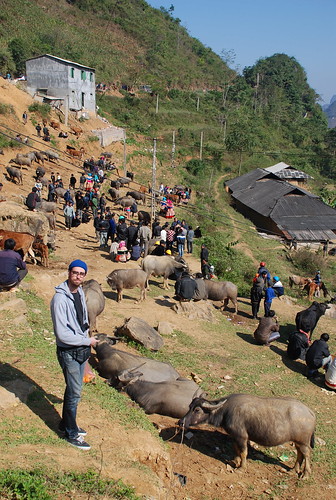
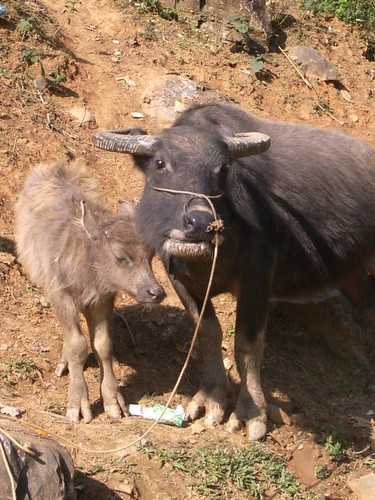
Here we could find suckling pigs being carved up.
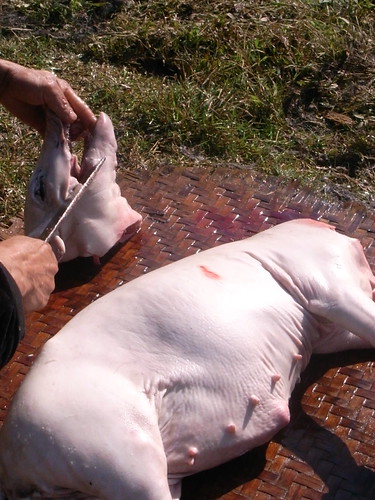
Drying Corn waiting to be crushed into grain.
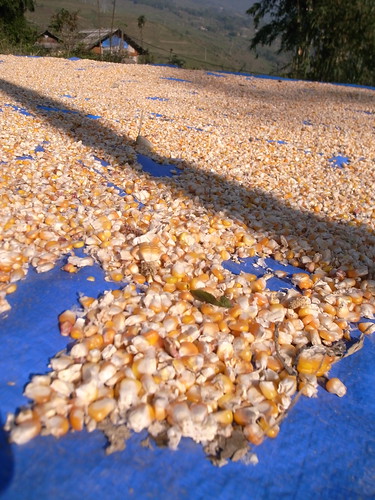
People munching on sugar cane, noodles, and fried rice cake similar in texture to mochi.
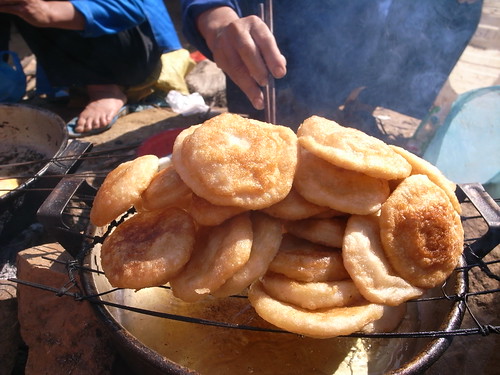
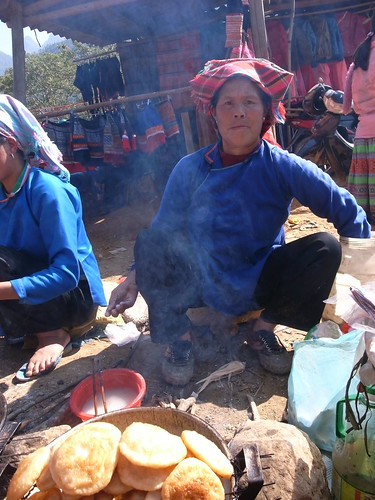
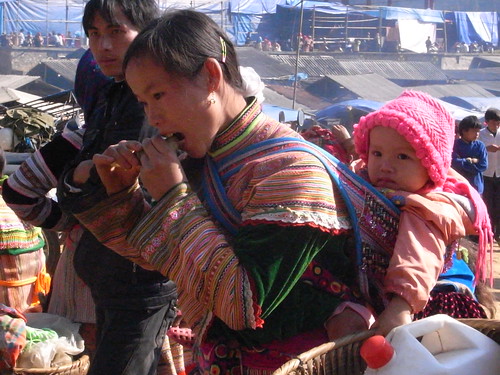

The Can Cao market was absolutely unlike everything I had ever seen. It was as though I walked through a doorway where I was entirely ignored and witnessed people do what have been doing for years.
*
Bryan lived in Tokyo for several years before moving to São Paulo with his wife. His primary mode of transportation is his bike.
 PREFACE
Lost in Luang Prabang
Our honeymoon was broken up into three different parts split between three countries, and two climates. Northern Vietnam was meant to be the adventurous leg of it.
Hanoi is loud. Damn loud. Instead of using turn signals, cars honk to indicate their next move. Not many traffic lights, only massive roundabouts and five-way intersections. One surprised taxi driver honked his way through chaos, then suddenly, his horn broke. Freaked out, the taxi driver slowed down and proceeded as though he were getting his learners permit. Hilarious: an unarmed taxi driver in the middle of a horn war.
PREFACE
Lost in Luang Prabang
Our honeymoon was broken up into three different parts split between three countries, and two climates. Northern Vietnam was meant to be the adventurous leg of it.
Hanoi is loud. Damn loud. Instead of using turn signals, cars honk to indicate their next move. Not many traffic lights, only massive roundabouts and five-way intersections. One surprised taxi driver honked his way through chaos, then suddenly, his horn broke. Freaked out, the taxi driver slowed down and proceeded as though he were getting his learners permit. Hilarious: an unarmed taxi driver in the middle of a horn war.
 Hanoisy.
It's my vote for the noisiest place on the planet. To survive crossing roads as a pedestrian, move slowly and directly to where you need to go. No running (your first instinct), take a deep breath and cautiously float through. This is the only way to get to your next pho.
Aside from the noise, it is great. The architecture, drinks, and food is all good. I was in search of northern-style pho--I heard about these thicker fatty noodles and wanted to get the real deal. We were lead astray at first by our guide who ditched us at the place with the best view and worst food in the old quarter.
Street meat: chicken parts.
Hanoisy.
It's my vote for the noisiest place on the planet. To survive crossing roads as a pedestrian, move slowly and directly to where you need to go. No running (your first instinct), take a deep breath and cautiously float through. This is the only way to get to your next pho.
Aside from the noise, it is great. The architecture, drinks, and food is all good. I was in search of northern-style pho--I heard about these thicker fatty noodles and wanted to get the real deal. We were lead astray at first by our guide who ditched us at the place with the best view and worst food in the old quarter.
Street meat: chicken parts.
 Mobile baguette vendors--a reminder of the former French empire.
Mobile baguette vendors--a reminder of the former French empire.
 Meat vendors.
Meat vendors.
 Vegetable vendors.
Vegetable vendors.
 Pho destination.
Pho destination.
 A little help with the menu got us our first nem (the sexier word for "spring roll from god"):
A little help with the menu got us our first nem (the sexier word for "spring roll from god"):
 The pho ruled--not because it was particularly memorable, but because this is what everyone else ate. It was hot and welcoming.
The pho ruled--not because it was particularly memorable, but because this is what everyone else ate. It was hot and welcoming.
 The pho wasn’t spiced up to please the massive flow of foreign travelers, cause there weren’t any. We ate, slept and headed out to Halong Bay with bellies full of thick fatty noodle pho-ness.
Halong Bay is a massive archipelago in the Gulf of Tonkin. The many islands spring out of the water like giant dragon teeth here and there and everywhere. This little cove is a World Heritage Site.
The pho wasn’t spiced up to please the massive flow of foreign travelers, cause there weren’t any. We ate, slept and headed out to Halong Bay with bellies full of thick fatty noodle pho-ness.
Halong Bay is a massive archipelago in the Gulf of Tonkin. The many islands spring out of the water like giant dragon teeth here and there and everywhere. This little cove is a World Heritage Site.
 Arriving at Halong Bay was a little bit like arriving at a cattle ranch: pushed out of our van and huddled into a banquet room awaiting what’s next. Here we were assigned “Bobby” the kind, yet dead pan, robotic-voiced guide. Bobby sharply and efficiently shouted out our names, then moved onto the next “RO-BOT!” or as the others knew him, Robert from Long Beach.
We got on our Junk, which is not the lovely between the leg region, but a large wooden pirate-esque ship with giant fan sails. The fleet of Junks quickly swallowed up their tourists and took them away.
Arriving at Halong Bay was a little bit like arriving at a cattle ranch: pushed out of our van and huddled into a banquet room awaiting what’s next. Here we were assigned “Bobby” the kind, yet dead pan, robotic-voiced guide. Bobby sharply and efficiently shouted out our names, then moved onto the next “RO-BOT!” or as the others knew him, Robert from Long Beach.
We got on our Junk, which is not the lovely between the leg region, but a large wooden pirate-esque ship with giant fan sails. The fleet of Junks quickly swallowed up their tourists and took them away.
 The above photo is of a woman paddling some tourists from our trip to a little water village. All the paddlers were women. Tough as nails.
First Junk meal was (surprise!) pho of the more flavorful variety, pho ga, with shredded chicken.
For dinner entertainment: a massive display of pumpkin art, which we were heavily encouraged to clap for as Bobby proudly displayed the next. These displays put North American Halloween pumpkin-carving to shame.
The above photo is of a woman paddling some tourists from our trip to a little water village. All the paddlers were women. Tough as nails.
First Junk meal was (surprise!) pho of the more flavorful variety, pho ga, with shredded chicken.
For dinner entertainment: a massive display of pumpkin art, which we were heavily encouraged to clap for as Bobby proudly displayed the next. These displays put North American Halloween pumpkin-carving to shame.


 On our first night on the Junk we were given a happy honeymoon cake, hand-delivered by Bobby and the Captain personally.
On our first night on the Junk we were given a happy honeymoon cake, hand-delivered by Bobby and the Captain personally.
 The next night we ate a plateful of crab. Vietnam doesn’t joke about their seafood.
The next night we ate a plateful of crab. Vietnam doesn’t joke about their seafood.
 An overnight train landed us in Sapa the old mountain town overlooking the border with China.
Sapa is home to at least ten ethnic minorities. We encountered mostly Flower H’mong, Black H’mong, and Red Zhao.
Flower H'mong:
An overnight train landed us in Sapa the old mountain town overlooking the border with China.
Sapa is home to at least ten ethnic minorities. We encountered mostly Flower H’mong, Black H’mong, and Red Zhao.
Flower H'mong:
 Black H'mong. phot0 courtesy of CH
Black H'mong. phot0 courtesy of CH
 Red Zhao:
Red Zhao:
 All the H'mongs were very friendly, intricately dressed, and pushing their handicrafts. And talking on the phone.
All the H'mongs were very friendly, intricately dressed, and pushing their handicrafts. And talking on the phone.
 At the Can Cao market in the high-rice terraced mountains we found thousands of colorfully clad Flower H’mong women buying up their new garments. From a distance, all the garments look the same, reminding me of the four pairs of blue jeans I had at home--and how that must look to outsider eyes.
At the Can Cao market in the high-rice terraced mountains we found thousands of colorfully clad Flower H’mong women buying up their new garments. From a distance, all the garments look the same, reminding me of the four pairs of blue jeans I had at home--and how that must look to outsider eyes.

 Check the detail.
Check the detail.
 The Can Cao market is the most important day of the week for this community. They don their best gear and walk up to 30 kilometers to buy and sell their garments, peanuts, dried peppers, rice, cane, and handicrafts.
The Can Cao market is the most important day of the week for this community. They don their best gear and walk up to 30 kilometers to buy and sell their garments, peanuts, dried peppers, rice, cane, and handicrafts.
 Their husbands usually come by scooter to sell and bid on water buffalo down the slope.
Their husbands usually come by scooter to sell and bid on water buffalo down the slope.

 Here we could find suckling pigs being carved up.
Here we could find suckling pigs being carved up.
 Drying Corn waiting to be crushed into grain.
Drying Corn waiting to be crushed into grain.
 People munching on sugar cane, noodles, and fried rice cake similar in texture to mochi.
People munching on sugar cane, noodles, and fried rice cake similar in texture to mochi.



 The Can Cao market was absolutely unlike everything I had ever seen. It was as though I walked through a doorway where I was entirely ignored and witnessed people do what have been doing for years.
*Bryan lived in Tokyo for several years before moving to São Paulo with his wife. His primary mode of transportation is his bike.
The Can Cao market was absolutely unlike everything I had ever seen. It was as though I walked through a doorway where I was entirely ignored and witnessed people do what have been doing for years.
*Bryan lived in Tokyo for several years before moving to São Paulo with his wife. His primary mode of transportation is his bike.




Comments (6)
Incredible and amazing. Seems like a timeloop from yesteryear.
thanks for these! i’m going to Hanoi in a few weeks, and am looking forward to seeing some of the same sights.
Beautiful photos Bryan! That’s a big plate of crabs!
Was that the most amazing trip you guys have ever been on? I’m so envious! The colors, the colors…
I think one of the more romantic cities to visit is Italy. I personally went there on my honeymoon and my husband and I loved the food and the people there! I would strongly suggest Rome and Florence. Although it can get very touristy, especially in the summer, they are very beautiful places with so much history and culture. To break free from the tourist crowd, I would suggest you to try
some home-dining options. We went to dine with one of the local hosts on BonAppetour, and were treated to a fancy meal at their homes on the rooftop! It is very simple to book a dinner with the hosts on their website too! Other than that, I would also suggest you to try taking one of those
Vespa tours, especially in the Florence country-side. Riding on the vespa with your partner across the green landscape is actually very thrilling and romantic! Hope this helped!
This is the first time I come to Sapa and first time I trekking here as well. So amazing!!! It surprised me by stunning beauty of yellow terrace field and corn paddy. We got into house of H’mong people. It was a good chance for me to communicate with people here to understand more how their life is and how difficult things they are getting. If you have never been in Sapa, it will be a miss!